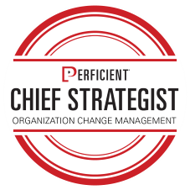Previously, I discussed meaningful training, and change management adoption. This blog dives into the different types of training styles in change management initiatives.
 Effective communication is not one size fits all. Studies have repeatedly shown that effective communication must be sent at least seven times over at least three channels for it to land and stick. You have to also send the right message to the right person at the right time. But what about training? A multi-pronged training curriculum is more difficult and time consuming to create than a given communication. With that in mind, can you get away with only creating one style of training for delivery? Probably not! There are two reasons for this: learning style and learning content.
Effective communication is not one size fits all. Studies have repeatedly shown that effective communication must be sent at least seven times over at least three channels for it to land and stick. You have to also send the right message to the right person at the right time. But what about training? A multi-pronged training curriculum is more difficult and time consuming to create than a given communication. With that in mind, can you get away with only creating one style of training for delivery? Probably not! There are two reasons for this: learning style and learning content.
Let’s approach learning style first. Just as we each have desired ways to receive and process communications, we each have a preferred way to absorb training. Some people like to attend a live, interactive instructor-led class, where they can be led through a “tell, show, do” approach. They can practice the concepts being taught, and have a chance for live Q&A with the instructor. Of course, this takes planning on the user’s part, possibly traveling to the location, and a formalized time to attend the class.
Others may prefer an on-demand training approach. This delivery style is dominated by computer-based training modules, stored locally on a learning management system or accessed via the web. Users can take training when it’s convenient for them.
There are pros and cons to each of these approaches. To be clear, there are more approaches than these, and even hybrids between the two. However, when users are training via a non-preferred approach, they’re usually there to get through it. They’re counting the minutes. Absent-mindedly clicking through slides. Multitasking. They’re not absorbing the content, and that’s a problem.
Now, the training content. For training to be truly effective, it must both apply to the situation at hand and resonate with the user. The users have to buy in to the purpose and application of the training. That means, at least to some extent, it must be customized to the user and ultimately the organization.
Of course, there is a lot of freeware training out there, but it’s generic by definition. It usually doesn’t apply to a specific situation and certainly not to a specific organization’s needs. For example, you won’t find much training out there that looks like your specific instance of Microsoft SharePoint, as it’s usually customized (look, feel, and functionality) to the your specifications.
We work with a number of training partners that have excellent web-based training content. It has its place, as it’s very effective for on-going, on-demand skill building. However, we always attempt to connect the dots for the users first. We generally do this via our communications strategy, helping the users understand what this will mean for them, and also via customized training at the outset that helps sets the foundation. We’ve found this works very well, and also sets our training partners up for long-term success.
We conducted a large-scale implementation of a leading collaboration tool at a Mid-Atlantic healthcare company with locations in multiple cities. Conducting live, in-person training for the entire company wasn’t an option for many reasons, and we didn’t like the idea of leveraging computer-based training. Therefore, we developed a hybrid approach that gave personized training to as many users as possible, and provided an online curriculum to help with the basics at go-live, as well as to provide a platform to enhance skills in the future.

To execute this approach, we created live, customized, and face-to-face training for select users – a combination of early adopters and power users who will be advocates and support those in the field. This train-the-trainer program was delivered in classrooms of 15-20 participants using PowerPoint, a live system, and hands-on exercises and activities in a sandbox environment (i.e., the tell, show, do approach). The training provided an overview of key activities that would be necessary to be operationally efficient at go-live without causing significant disruption. This training will cascade to employees face-to-face via the “trainers” and was also recorded for future use.
In addition, we built quick-reference guides for key activities to be used in the early days after implementation. We leveraged our partner Brainstorm and its subscription-based model for on-demand video vignettes that users can watch on demand. As there are thousands of Brainstorm Office 365 videos available, we created a virtual playlist to aid users in efficiently finding relevant videos.
This approach was well received by our client. It allows different users to move at their desired pace, as well as provides access to content that is most relevant for their given roles. Finally, we regularly survey our training participants for feedback so that we can make the training more meaningful and effective. Before you throw generic, one-size-fits-all training at your next project, think hard about the impact you want to have.
To learn more about the key concepts of change management and how to overcome challenges to achieve success, you can click here or download the guide below.

